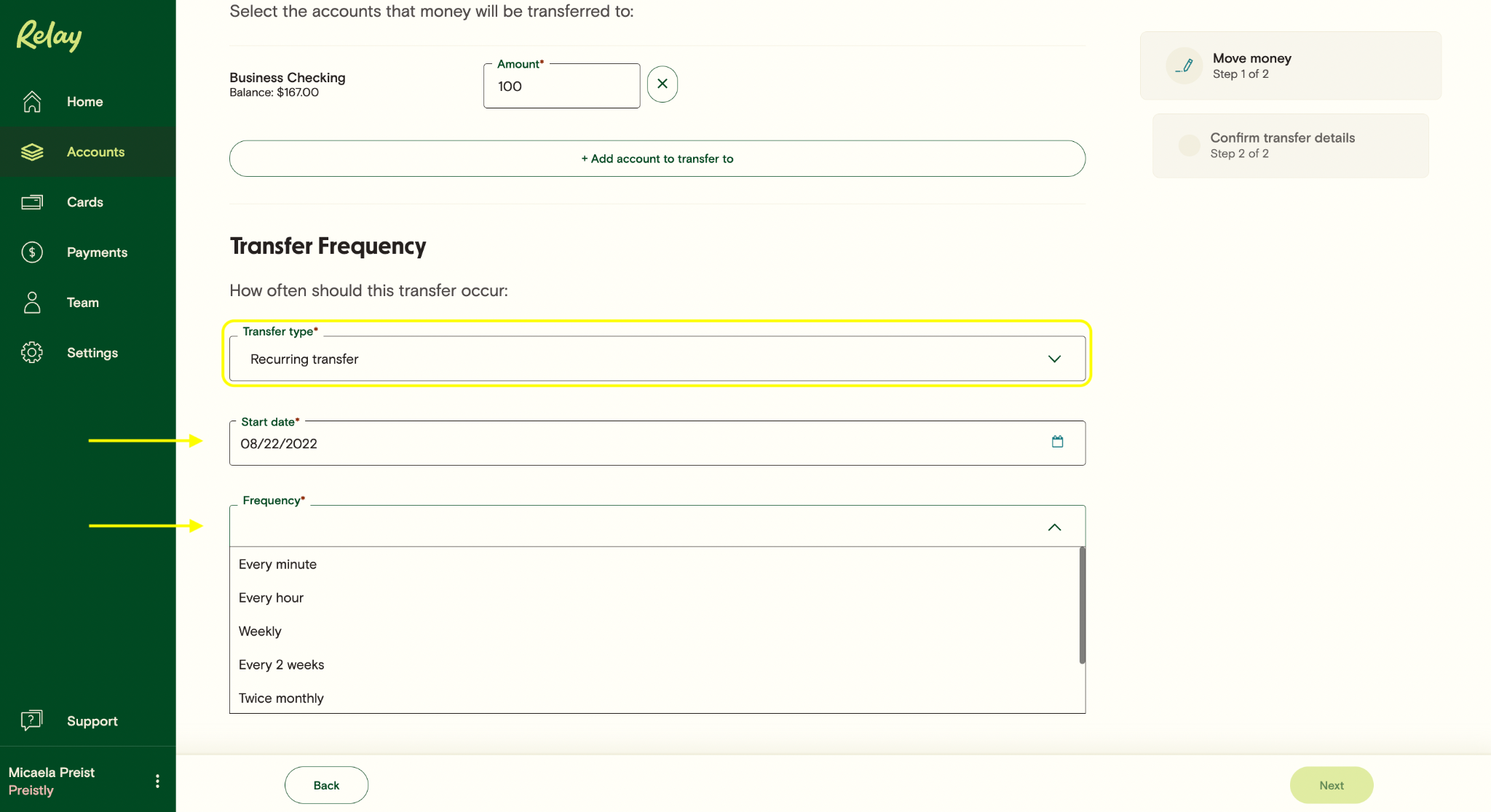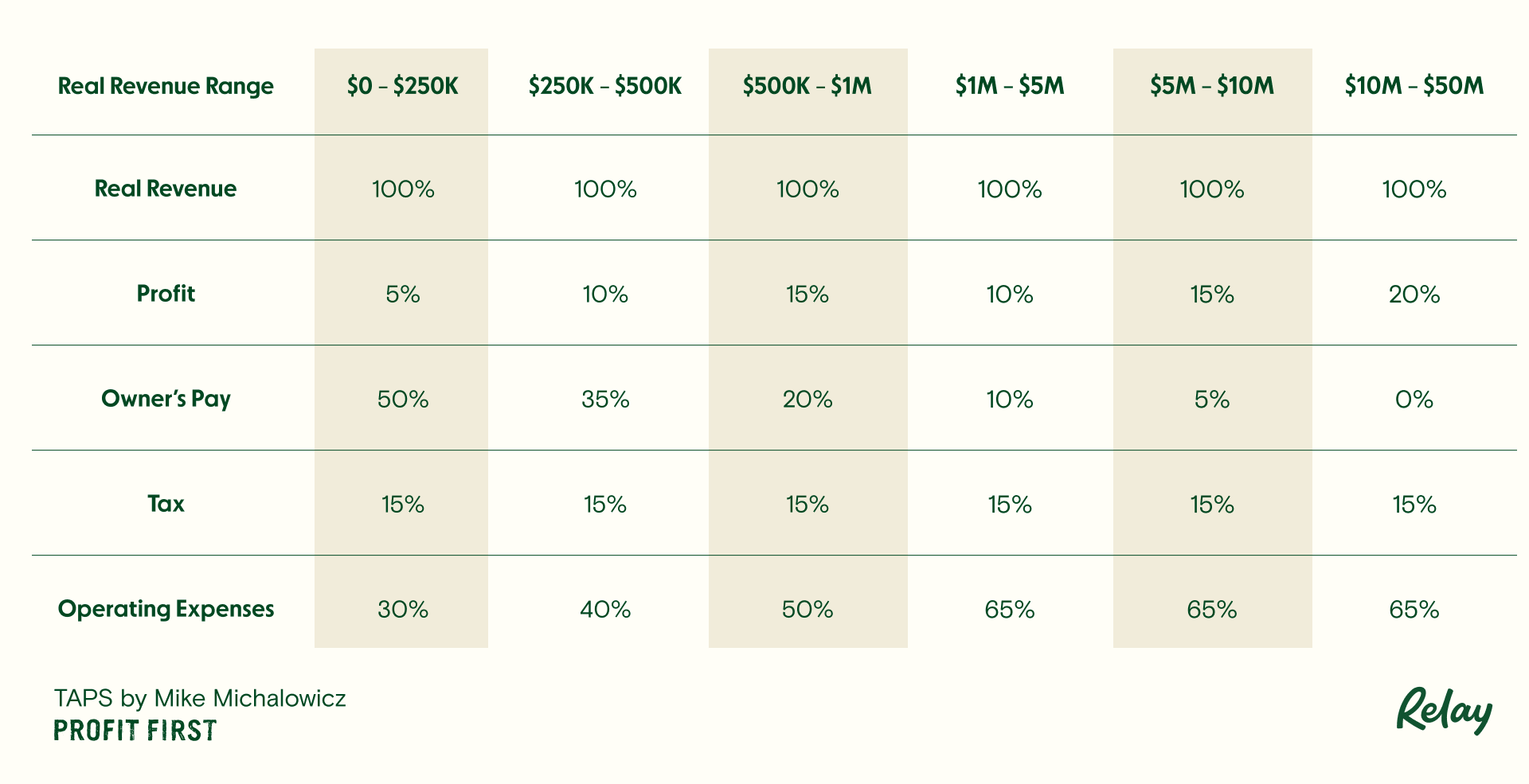The problem is that putting profit last can hinder business growth and lead to financial instability. The good news is that there’s a better way to manage your cash flow: the Profit First method. 🤑
The Profit First method makes profit a business’s top priority. Unlike traditional approaches, which focus solely on revenue, Profit First aims to make businesses immediately and permanently profitable. 💯
The Profit First method involves intentionally dividing revenue across different bank accounts, including a profit account. This practice can help business owners create their own profit margin from day one, instead of allowing expenses to grow faster than the business.
Let’s dive into the details so you can learn exactly how Profit First works, how to determine if it’s the right fit for you, and how you can get started with Profit First today.
What is Profit First accounting? 🤔
Profit First is a system of accounting that put simply, prioritizes profit. Businesses that use this method set aside a percentage of profit first, and then determine how many expenses they can afford. 💸
The system centers around the idea of literally separating your revenue into different accounts, most importantly, the profit account. Basically, you can think of it as the envelope method of personal finance applied to business.
Traditional method of accounting: sales – expenses = profit
Profit First method of accounting: sales – profit = expenses
Profit First is a groundbreaking approach because entrepreneurs are traditionally taught to focus on revenue growth, regardless of the expense. As a result, a business’s profit margin is seen as something to be optimized and improved later. Unfortunately, that can lead a business to run out of cash quickly, and ultimately, fail. 📉
<!-- EMBEDDED_ENTRY_INLINE:6miO3cNYvJKf7lnmX7tB13:inlineCta -->
Who wrote Profit First? 📝
After selling and launching two multi-million dollar companies, author Mike Michalowicz realized how difficult it was to build a profitable business using traditional cash flow management methods. Based on those experiences, Michalowicz came up with the principles of Profit First and wrote the book Profit First: Transform Your Business from a Cash-Eating Monster to a Money-Making Machine in 2014. 📗
Why is the Profit First method effective? 🤑
The Profit First method is so effective because it’s based on behavioral laws, like Parkinson’s Law. This law states that work 🧑💻 will expand depending on the amount of time available to complete the work, and it can also be applied to your finances.
Parkinson’s Law is the reason that even million-dollar businesses can end up with zero dollars in their bank accounts. When you have money sitting around without a defined purpose, you’ll find a reason to spend it — that’s just human nature. 🤷♀️
But when business owners make profit a habit, it can help them avoid overextending themselves. They’ll be able to make informed decisions about how to allocate their resources and gain more control over their financial performance. 🙌
How does Profit First work? 🛠
You might be wondering what Profit First actually looks like in practice. Well, the power of this accounting method comes from its simplicity. Here are the four steps required to implement Profit First with your business.
1. Determine your profit margin 💰
First, you need to determine what percentage of your revenue you want to allocate to profit. A common recommendation is to aim for a profit margin of at least 5% depending on your business goals and financial needs. If you can’t afford a profit margin right now, you may need to step back and re-evaluate your business budget. 📝
2. Set up the five Profit First accounts 💵
Next, you'll need to set up separate bank accounts for your business, including a checking account, a profit account, and accounts for other expenses such as business taxes and owner's pay. You may also want to set up a savings account to save for potential business emergencies.
3. Allocate revenue to each account 💸
After profit is set aside, you’ll need target allocation percentages for each of your accounts. For example, you might aim to allocate 10% of your revenue to the profit account, 40% to the owner’s compensation account, 30% to the OpEx account, and 20% to the taxes account.
4. Pay expenses from the appropriate accounts 💳
The last step is ensuring your expenses come from the OpEx checking account, your taxes come from the taxes account, etc. Doing this will allow you to maintain your budget without eating into your profit. It will also help you get crystal clear 💎 on how much you’re earning, spending, and saving at any given time.
<!-- EMBEDDED_ENTRY_INLINE:2ub48BYrxuYqnf0PJ8kMNa:inlineCta -->
What are the benefits of Profit First?
Managing your business finances with Profit First can be life-changing. Instead of leaving your most important business metric up to chance, Profit First helps business owners keep their focus on profit. Here are three more benefits of using the Profit First system.
Makes prioritizing profit a habit. 👍 It’s risky to let profit be your business’s last priority. However, human nature dictates that if we see money, we’re likely to spend it. That’s why Profit First is so great: it pushes you to automatically put profit aside before you even see it in your checking account.
Helps businesses plan for the future. 🔮 It can be tough to save for expenses like taxes when your business’s cash flow is inconsistent. Profit First helps by reminding you to set aside a specific percentage from every sale — even if it’s just a few dollars. Over time, that discipline will pay off.
Keeps your business organized. 🙌 Business expenses can be challenging to manage. Separating your revenue into different accounts will keep you organized and simplify the process. Instead of guessing, you’ll know exactly how much money you have for OpEx, taxes, and your other goals.
What are the disadvantages of Profit First?
Many businesses have turned to Profit First as a method for intentionally increasing profit. The process often works because it’s so simple. However, every business is unique, and there’s no one-size-fits-all solution for accounting. Before you jump into the Profit First method, let’s take a look at some potential downsides.
Can be tough to implement. 😬 Profit First requires a minimum of five separate accounts. Depending on your bank, this can be complicated to set up. Plus, most traditional banks charge a monthly maintenance fee, especially for business accounts. Those can rack up quickly if you have multiple accounts.
Might be time-consuming. ⏳ If you don’t have an accountant or a bank that allows you to set up automatic deposits, you could find yourself separating your revenue each month manually. That can require a lot of time that you don’t have as a small business owner.
Can be tricky if a business has high overhead costs.💰 Your company might have a lot of expenses, such as rent, payroll costs, and property taxes. If the business’s profit margin is already tight or nonexistent, then separating funds across accounts might not make sense.
Can be challenging for businesses with a lot of debt. 💵 Similar to the above, if your business is paying off large amounts of debt, it might not have the cash needed to implement Profit First. These businesses may want to consider paying off debt first and implementing Profit First later.
What is the best bank for Profit First? 💰
If you’re ready to get started with Profit First, you’ll need to start by evaluating your banking options. Even if you already have a business bank account, your current bank might not be the best fit for implementing Profit First.
If you’re currently using a traditional bank for your business finances, you may want to look for an alternative. That’s because these banks rarely allow you to set up multiple free checking accounts. And if you’re charged a maintenance fee for every Profit First account, every month, that can add up quickly.
But here’s the great news: today, digital banks provide a wide variety of innovative solutions for business owners. We’d even argue that Relay, our online banking and money management platform, is the best solution for anyone who wants to implement Profit First. 😎
Here are just a few reasons why:
You can open accounts remotely 🙌
No account fees 🥳
No minimum balance requirements 💸
Multiple free checking accounts 🤯
Multiple physical and virtual debit cards 💳
We also make it incredibly easy for business owners to set up recurring, percentage-based transfers between accounts. 👏 That means you can put your profit on autopilot instead of manually calculating transfers each month.
Another feature that our Profit First users love? Relay’s balance-based transfer rules. 🎉 For example, a user can create a rule that says when one Relay account hits a certain amount of money, money will be automatically dispersed to their other accounts based on preset percentages.
💡Want to give Relay a try? Check out our comprehensive guide to changing business banks or sign up here. Believe it or not, the process isn’t as complicated as you might think. 🤔
How to set up Profit First in Relay ✅
Setting up Profit First might seem complicated, but Relay makes the process seamless. If you’re ready to start making profit a priority in your business, follow these four steps to get started with Relay.
1. Open your first Relay account from anywhere 🌎
Getting started with Relay is easy. To open a traditional business bank account, you have to visit a branch in person. But with Relay, you can complete the entire process online.
We support business owners from over 200 countries around the world, including the United States, Canada, the United Kingdom, and Australia. As long as the business has an operating presence in the U.S., you can open your business checking accounts with Relay.
2. Create your first 5 Profit First accounts
After you’ve logged into your Relay account, make sure to add funds by directly connecting an existing bank account, sending/receiving ACH payments, or mobile check deposits.
Next, it’s time to set up your Profit First checking accounts. With a few clicks of your mouse, you can open your accounts, label them, and transfer funds to each one. Users love this feature because they can open up to 20 free, individual checking accounts — not just sub-accounts. 🙌
That means you can issue debit cards 💳 and connect them to a specific checking account. That will keep you and your business organized and on track with your spending goals. For example, you can use OpEx debit card to spend from your expense account.
Don’t want to use a debit card? No problem, we offer automated bill pay features, too. 😎
3. Set up recurring, percentage-based transfers
As we said above, Relay allows you to automate Profit First by setting up recurring percentage-based transfers. Profit First suggests that business owners transfer funds twice a month, but you can do this however works best for your company. At a minimum, you should transfer funds monthly.
4. Distribute funds quarterly
The Profit First system suggests that business owners take 50% of their profit accounts each quarter as a profit distribution. The remaining 50% can be reinvested into the business or saved for future goals. 💰You can also take funds from your other accounts each quarter depending on your needs, such as making quarterly tax payments in the U.S.
Is Profit First right for you?
Ultimately, Profit First helps business owners and entrepreneurs allocate their resources in a way that maximizes their profits and creates sustainable growth. 📈 If you’re ready to take control of your finances and prioritize profit, this accounting method is right for you.
FAQs about Profit First
How do you calculate Profit First?
The Profit First formula is simple: Revenue – Expenses = Profit.
What are the 5 Profit First accounts?
Mike Michalowicz specifically recommends these five Profit First accounts:
Income account
Owners compensation account
Operating expenses (OpEx) account
Profit account
Tax account
What are the Profit First Percentages?
This chart by Profit First shows the recommended percentages for small businesses based on annual revenue.
Will Profit First help my business grow?
Instead of relying on debt or sacrificing your profit margin to grow, Profit First helps business owners prioritize financial stability. But that doesn’t mean followers of Profit First won’t grow — the difference is that they can choose to reinvest the business’s profits, rather than relying on money they don’t have.
You might have heard the saying, “you have to spend money to make money.” While there may be some wisdom behind the phrase, followers of the Profit First method would argue that you can spend the money — it just needs to come from your profit account.
Who should use Profit First?
45% of small businesses fail within the first 5 years, and usually, it’s because they run out of money. Profit First is for any entrepreneur or business owner who wants to improve their company’s financial health, get expenses under control, and create sustainable growth.
<!-- EMBEDDED_ENTRY_INLINE:5aN2V4kHU4Pz2HXZfN5Jz8:inlineCta -->







